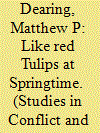|
|
|
Sort Order |
|
|
|
Items / Page
|
|
|
|
|
|
|
| Srl | Item |
| 1 |
ID:
152965


|
|
|
|
|
| Summary/Abstract |
In the recent era of state formation in Afghanistan, hundreds of small popular movements rebelled against the Taliban throughout the country. One in particular stands out – the Andar Uprising in the spring of 2012 gave a compelling case of local vigilantism in an area ripe with historic grievances and narratives of community defense dating back to the anti-Soviet jihad. This case is compelling as it shows one faction of the movement engaging in protective paramilitary behavior over the civilian population, while the other faction engages in predatory behavior. Controlling processes, incentives structures, and narratives were all factors correlating to the rise of a popular anti-Taliban resistance in Andar District that battled the Taliban and perceived oppression in their district. When patrons and the community engaged in complementary governance over the paramilitary group, in this case through the Afghan Local Police (ALP), paramilitary behavior was protective of the civilian population. However, when patrons and communities failed to provide complementary governance, as the case of the remaining Uprising force after ALP institutionalization, the paramilitaries engaged in predation on the local population.
|
|
|
|
|
|
|
|
|
|
|
|
|
|
|
|
| 2 |
ID:
099787


|
|
|
|
|
| Publication |
2010.
|
| Summary/Abstract |
In an era where female suicide terrorism is on the rise in conflict regions such as the Middle East, the North Caucasus, and South Asia, why has Afghanistan been largely immune to this trend? Why do some violent groups use female suicide terrorism and others avoid it? This is a critical question for policy makers and analysts attempting to understand a dangerous terrorist phenomenon and how it may evolve in Afghanistan. During the anti-Soviet jihad, narratives were woven of men and women marching through the mountains of Nuristan to "offer their blood for the Islamic revolution like red tulips at springtime." But today, women are wholly absent from the Taliban and their jihad in Afghanistan. This article analyzes, in particular, the absence of women in Taliban martyrdom operations. There are three primary findings from this study that explain the low propensity for female suicide bombers in Afghanistan. First, a permissive social and geographic environment in Afghanistan gives insurgents freedom of mobility and a resistance capacity characterized by a reduced necessity for female suicide bombers; second, the capacity of a fiercely conservative culture restricts female participation in both Afghan society and within insurgent organizations; and third, the pronounced absence of a female culture of martyrdom limits women from participation in insurgent actions and narratives.
|
|
|
|
|
|
|
|
|
|
|
|
|
|
|
|
| 3 |
ID:
165186


|
|
|
|
|
| Summary/Abstract |
The American way of war in Afghanistan presents a conundrum for proponents of 21st-century state-building projects. How can liberal peace proponents engage in efficient state building without sacrificing their ideals? The US learned that state-building allocates a degree of command and control to powerbrokers operating in the shadows to launder aid money, traffic illicit narcotics, and engage in extrajudicial punishments. These clients failed to represent the liberal values foreign patrons endorsed, because the latter not only offered resources without conditions but also rewarded bad behavior. This issue is examined by looking at the case of post-2001 northern Afghanistan, where powerful warlords should have held greater control over their paramilitary forces, limited predatory behavior, and built stronger relationships with the community. Instead, warlords-turned-statesmen expanded their material and social influence in the north, while holding onto the informal instruments of racketeering and patronage that overwhelmed Western ideals and shaped the predatory state present in Afghanistan today. Moreover, paramilitaries were influenced by material, social, and normative incentives that rewarded violent and predatory behavior and further eroded already weak community control mechanisms at the subdistrict level.
|
|
|
|
|
|
|
|
|
|
|
|
|
|
|
|
|
|
|
|
|